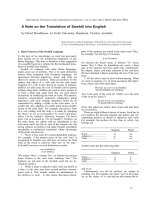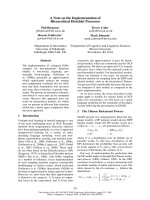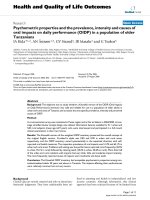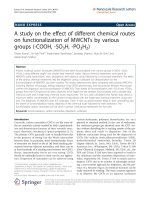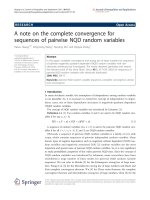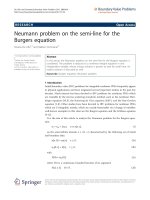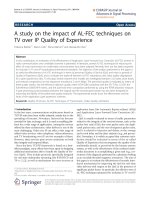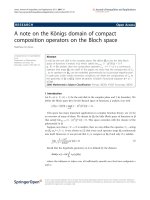Báo cáo hóa học: " A note on the complete convergence for sequences of pairwise NQD random variables" potx
Bạn đang xem bản rút gọn của tài liệu. Xem và tải ngay bản đầy đủ của tài liệu tại đây (234.8 KB, 8 trang )
RESEARC H Open Access
A note on the complete convergence for
sequences of pairwise NQD random variables
Haiwu Huang
1,2*
, Dingcheng Wang
1
, Qunying Wu
2
and Qingxia Zhang
1
* Correspondence:
1
School of Mathematics Science,
University of Electronic Science
and Technology of China,
Chengdu 610054, PR China
Full list of author information is
available at the end of the article
Abstract
In this paper, complete convergence and strong law of large numbers for sequences
of pairwise negatively quadrant dependent (NQD) random variables with non-
identically distributed are investigated. The results obtained generalize and extend
the relevant result of Wu (Acta. Math. Sinica. 45(3), 617-624, 2002) for sequences of
pairwise NQD random variables with identically distributed.
2000 MSC: 60F15.
Keywords: pairwise NQD random variable sequences, complete convergence, almost
sure convergence
1 Introduction
In many st ochastic models, the assumption of independence among random variables
is not plausible. So, it is necessary to extend the concept of independence to depen-
dence cases, one of these dependence structures is negatively quadrant dependent
(NQD) random variables.
The concept of NQD random variables was introduced by Lehmann [1].
Definition 1.1 [1] Two random variables X and Y are said to be NQD random vari-
ables if for any x, y Î R,
P
(
X < x, Y < y
)
≤ P
(
X < x
)
P
(
Y < y
).
(1:1)
A sequence of random variables {X
n
; n ≥ 1} is said to be pairwise NQD random vari-
ables if for all i ≠ j , i, j Î N, X
i
and X
j
are NQD random variables.
Obviously,asequenceofpairwiseNQDrandom variables is a family of very wide
scope, which contains sequences of pairwise independe nt random variables. Many
known types of negative dependence such as negatively orthant dependent (NOD) ran-
dom variables and negatively associated (NA) [2] random variables are the most
important and special cases of pairwise NQD random variables. So, it is very significant
to study probabilistic properties of this wider pairwise NQD class. Since the concept of
NQD random variables was introduced by Lehmann, many r esearchers have been
established a large number of limit results for pairwise NQD random variable
sequences. We can refer to Matula [3] for the Kolmogo rov strong law of large num-
bers, Wang et al. [4] for the Marcinkiewicz strong law of large numbers and Baum and
Katz complete convergence theorem, Wu [5] for Three series theorem, the complete
convergence theorem and Marcinkiewicz strong law of large numbers, Chen [6] for the
Huang et al. Journal of Inequalities and Applications 2011, 2011:92
/>© 201 1 Huang et al; licensee Springer. This is an Op en Access article distributed under the terms of the Creative Commons Attribution
License ( which permits unrestricted use, distribution, and reproduction in any medium,
provided the original work is properly ci ted.
Kolmogorov-Chung-type strong law of large numbers, Gan and Chen [7] for the strong
stability of Jamison’s weig hted sums. But most of th eir results were achieved under the
identically distributed condition and some results were obtained even under the condi-
tion of * (1) <1, where
ϕ
∗
(1) = lim
m→∞
sup
n≥m
sup
A∈F
n
m
,B∈F
∞
n
+1
,P(A)>0
|P(B|A) − P(B)|
.
When these are compared with the corresponding results of independent random
variable sequences, there still remains much to be desired.
The concept of complete convergence of a sequence of random variables was intro-
duced by Hsu and Robbins [8]. A sequence of random variables converges completely
to the constant c if
∞
n
=1
P( |X
n
− c| >ε) < ∞ for any ε>0
.
(1:2)
In view o f the Borel-Cantelli lemma, this implies that X
n
® c almost surely. Hence,
the complete convergence is a very impo rtant tool in establishing almost sure conver-
gence of summation of random variables. Hsu a nd Robbins [8] proved that the
sequence of ar ithmetic means of independent and identically distributed random vari-
ables converges completely to the expected value if the variance of the summands is
finite. Erdös [9] proved the converse. The result of Hsu-Robbins-Erd ös is a fundamen-
tal theorem in probability theory and has been intensively investigated in several direc-
tions by many authors in the past decades. One of the most important results is Baum
and Katz [10] strong law of large numbers.
Theorem A [10] Let ap ≥ 1, p>2, and let {X
n
; n ≥ 1} be a sequence of independent
and identically distributed random variables and E|X
1
|
p
< ∞.If
1
2
<α≤ 1
,assumethat
EX
n
=0,n ≥ 1. Then
∞
n=1
n
αp−2
P(max
1≤j≤n
j
i=1
X
i
>εn
α
) < ∞ for all ε>0
.
(1:3)
Wu [5] extended the result of Baum and Katz [10] to pairwise NQD random variable
sequences with identically distributed under the condition of ap > 1 and 0 <p <2.
Theorem B [5] Let ap >1,0<p <2,andlet{X
n
; n ≥ 1} be a sequence of identicall y
distributed pairwise N QD random variables and E |X
1
|
p
< ∞.If
1
2
<α≤
1
, assume that
EX
n
=0,n ≥ 1. Then
∞
n=1
n
αp−2
P
⎛
⎝
max
1≤j≤n
j
i=1
X
i
>εn
α
⎞
⎠
< ∞ for all ε>0
.
(1:4)
In this articl e, complete convergence and strong law of large numbers for sequences
of pairwise NQD random variables with non-identically distributed are investigated.
The main results obtained generalize and extend the relevant result of Wu [5] for
sequences of pairwise NQD random variables with identically distributed.
Huang et al. Journal of Inequalities and Applications 2011, 2011:92
/>Page 2 of 8
2 Main results
Throughout this article, the symbol c denotes a positive constant which is not necessa-
rily the same one in each appearance, a
n
= O(b
n
) will mean a
n
≤ c(b
n
), and a
n
≪ b
n
will mean a
n
= O(b
n
).
We will use the following concept in this article. Let {X
n
; n ≥ 1}beasequenceof
NQD random variables and let X be a n onnegative random variable. If there exists a
constant such that
sup
n
≥
1
P( |X
n
|≥t) ≤ cP(X ≥ t)forallt ≥ 0
.
Then, {X
n
; n ≥ 1} is said to be stochastically dominated by X (briefly {X
n
; n ≥ 1} π X).
Clearly if {X
n
; n ≥ 1} π X,thenfor0<p < ∞, E |X
n
|
p
≤ cEX
p
for any n ≥ 1. Now we
state the main results of this article.
Theorem 2.1 Let {X
n
; n ≥ 1} be a sequence of non-identically distributed pairwise
NQD random variables with {X
n
; n ≥ 1} π X and E|X|
p
< ∞ ,0<p <2andlet
S
n
=
n
i
=1
X
i
. When 1 ≤ p < 2, assumes that EX
n
=0,n ≥ 1. Then
∞
n
=1
n
−1
P
max
1≤j≤n
|S
j
| >εn
1/p
log n
< ∞ for all ε>0
.
(2:1)
Theorem 2.2 Let {X
n
; n ≥ 1} be a sequence of non-identically distributed pairwise
NQD random variables with {X
n
; n ≥ 1} π X and E|X|
p
< ∞ ,0<p <2andlet
S
n
=
n
i
=1
X
. When 1 ≤ p < 2, assumes that EX
n
=0,n ≥ 1. Then
lim
n→∞
S
n
n
1/p
lo
g
n
=0 a.s
.
(2:2)
3 Proof of main results
To prove our main results, we need the following lemmas.
Lemma 3.1 [1] Let X and Y be NQD, then
(1) EXY ≤ EXEY ;
(2) P(X>x, Y >y) ≤ P(X >x)P(Y >y), for any x, y Î R;
(3) If f, g are both nondecreasing (or non-increasing) functions, then f(X)andg(Y )
are NQD.
Lemma 3.2 [5] Let {X
n
; n ≥ 1} be a sequence of pairwise NQD random vari ables
with EX
n
= 0 and
EX
2
n
<
∞
for all n ≥ 1. Then
(1)
E
n
i=1
X
i
2
≤
n
i=1
EX
2
i
, for all n ≥ 1;
(2)
E max
1≤j≤n
j
i=1
X
i
2
≤
4log
2
n
log
2
2
n
i=1
EX
2
i
, for all n ≥ 1;
Proof of Theorem 2.1 Let
X
(
n
)
i
= X
i
I(|X
i
|≤n
1/p
)+n
1/p
I(X
i
> n
1/p
) − n
1/p
I(X
i
< −n
1/p
)
,
S
(n)
j
=
j
i
=1
X
(n)
i
, for any i ≥ 1. For all ε >0, first we show that
n
−1/p
max
1≤j≤n
j
i=1
EX
(n)
i
→ 0
.
(3:1)
Huang et al. Journal of Inequalities and Applications 2011, 2011:92
/>Page 3 of 8
(1) when 0 <p < 1, then
n
−1/p
max
1≤j≤n
j
i=1
EX
(n)
i
≤ n
−1/p
n
i=1
EX
(n)
i
= n
−1/p
n
i=1
EX
i
I(|X
i
|≤n
1/p
)
+
n
i=1
P( |X
i
| > n
1/p
)
n
1−1/p
E|X|I(|X|≤n
1/p
)+2nP(|X| > n
1/p
)
≤ n
1−1/p
E|X|I(|X|≤n
1/p
)+2n
E|X|
n
1/p
≤ n
1−1/p
E|X|I(|X|≤n
1/p
)
= n
1−1/p
n
k
=1
E|X|I(k − 1 < |X|
p
≤ k)
(3:2)
Since,
∞
k=1
k
1−1/p
E|X|I(k − 1 < |X|
p
≤ k)=
∞
k=1
k
1−1/p
E|X|
p
|X|
1−p
I(k − 1 < |X|
p
≤ k)
≤
∞
k=1
k
1−1/p
E|X|
p
I(k − 1 < |X|
p
≤ k)k
(1−p)/
p
=
∞
k=1
E|X|
p
I(k − 1 < |X|
p
≤ k)
= E
|
X
|
p
< ∞.
(3:3)
It follows from Kronecker lemma that
n
1−1/p
n
k
=1
E|X|I(k − 1 < |X|
p
≤ k) → 0asn →∞
.
(3:4)
Hence, we get that
n
−1/p
max
1≤j≤n
j
i=1
EX
(n)
i
→ 0asn →∞
.
(3:5)
(2) when 1 ≤ p <2,byEX
n
= 0 and E|X|
p
< ∞, then
n
−1/p
max
1≤j≤n
j
i=1
EX
(n)
i
≤ n
−1/p
n
i=1
EX
(n)
i
= n
−1/p
n
i=1
E(X
i
− X
(n)
i
)
= n
1−1/p
E((X − n
1/p
)I(X > n
1/p
)+(X + n
1/p
)I(X < −n
1/p
)
)
≤ n
1−1/p
E(|X|I(|X| > n
1/p
)+n
1/p
I(|X| > n
1/p
))
n
1−1/p
E|X|
p
n
(1−p)/p
I(|X| > n
1/p
)
= E|X|
p
I
(
|X| > n
1/p
)
→ 0
(3:6)
From (3.5) and (3.6), we easily know that (3.1) follows.
Huang et al. Journal of Inequalities and Applications 2011, 2011:92
/>Page 4 of 8
By (3.1), for any ε >0, n large enough, it follows from that
max
1≤j≤n
j
i=1
EX
(n)
i
<
ε
2
n
1/p
<
ε
2
n
1/p
log n,
n
i=1
EX
(n)
i
<
ε
2
n
1/
p
(3:7)
It follows from (3.1) that for n large enough
P
max
1≤j≤n
|S
j
| >εn
1/p
log n
≤
n
j
=1
P(|X
j
| > n
1/p
)+P
max
1≤j≤n
S
(n)
j
− ES
(n)
j
>
ε
2
n
1/p
log n
(3:8)
Hence, we need only to prove that
I
∞
n=1
n
−1
n
j
=1
P( |X
j
| > n
1/p
) < ∞
.
(3:9)
and
II
∞
n
=1
n
−1
P
max
1≤j≤n
|S
(n)
j
− ES
(n)
j
| >
ε
2
n
1/p
log n)
< ∞
.
(3:10)
By E|X|
p
< ∞, then
I
∞
n=1
n
−1
n
j
=1
P( |X
j
| > n
1/p
) <
∞
n=1
P( |X| > n
1/p
) E|X|
p
< ∞
.
(3:11)
Denote that
˜
X
(n)
i
= X
(n)
i
− EX
(n)
i
,
˜
S
(n)
j
=
j
i
=1
˜
X
(n
)
i
,
α =
1
p
, then, we know that
E
˜
X
(
n
)
i
=
0
.It
follows from Lemma 3.2 and Markov inequality that
II
∞
n=1
n
−1
P
max
1≤j≤n
S
(n)
j
− ES
(n)
j
>
ε
2
n
1/p
log n
∞
n=1
n
−1−2α
log
−2
nE
max
1≤j≤n
˜
S
(n)
j
2
≤ c
∞
n=1
n
−1−2α
log
−2
nlog
2
n
n
i=1
E(
˜
X
(n)
i
)
2
≤ c
∞
n=1
n
−2α
E|X|
2
I(|X |≤n
1/p
)+c
∞
n=1
P(|X| > n
1/p
)
≤ c
∞
n=1
n
−2α
n
k=1
E|X|
2
I(k − 1 < |X|
p
≤ k)+cE|X|
p
≤ c
∞
k=1
E|X|
2
I(k − 1 < |X|
p
≤ k)
∞
n=k
n
−2α
≤ c
∞
k=1
k
−2α+1
E|X|
2
I(k − 1 < |X|
p
≤ k)
= c
∞
k=1
k
−2α+1
E|X|
p
|X|
2−p
I(k − 1 < |X|
p
≤ k)
≤ c
∞
k=1
k
−2α+1
E|X|
p
k
(2−p)/p
I(k − 1 < |X|
p
≤ k)
= c
∞
k=1
E|X|
p
I(k − 1 < |X|
p
≤ k)
cE
|
X
|
p
< ∞.
(3:12)
Huang et al. Journal of Inequalities and Applications 2011, 2011:92
/>Page 5 of 8
The proof of Theorem 2.1 is complete.
Remark 3.1 Theorem 2.1 shows that when ap = 1, Baum and Katz complete conver-
gence theorem for pairwise NQD random variable sequences still holds true under the
strong er condition. The result generalizes and extends the corr esponding result of Wu
[5] for sequences of pairwise NQD random variables with identically distributed.
Remark 3 .2 Under the conditi ons of Theorem 2.1, it is well known that (2.1) holds
for 0 <p < 1 without the factor log n, i.e.
∞
n
=1
n
−1
P(max
1≤j≤n
|S
j
| >εn
1/p
) < ∞ for 0 < p < 1 and any ε>0
.
Proof of Theorem 2.2 For all ε >0, from (2.1), we obtain that
∞
n
=1
n
−1
P(max
1≤j≤n
|S
j
| >εn
1/p
log n) < ∞.
Then we know that
∞ >
∞
n=1
n
−1
P(max
1≤j≤n
|S
j
| >εn
1/p
log n)
=
∞
i=0
2
i+1
−1
n=2
i
(2
i+1
− 1)
−1
P(max
1≤j≤n
|S
j
| >εn
1/p
log n
)
≥
1
2
∞
i
=1
P(max
1≤j≤2
i
|S
j
| >ε2
(i+1)/p
log(2
i+1
)).
(3:13)
It follows from Borel-Cantelli lemma that
P(max
1≤
j
≤2
i
|S
j
| >ε2
(i+1)/p
log(2
i+1
), i.o.) = 0
.
(3:14)
Hence,
lim
i→∞
max
1≤j≤2
i
|
S
j
|
2
(i+1)
/p
log
(
2
i+1
)
=0. a.s
.
(3:15)
For all positive integers n, t here exists a non-negative integer i
0
, such that
2
i
0
−1
≤
n < 2
i
0
.
Thus
max
2
i
0
−1
≤n≤2
i
0
|S
n
|
n
1/p
log n
≤
max
1≤j≤2
i
0
|S
j
|
2
(i
0
−1)/p
log(2
i
0
−1
)
≤ 2
2
p
max
1≤j≤2
i
0
|S
j
|
2
(i
0
+1)/p
log(2
i
0
+1
)
i
0
+1
i
0
− 1
→
0. a.s.
(3:16)
We have
lim
n→∞
|
S
n
|
n
1/p
lo
g
n
=0. a.s
.
(3:17)
The proof of Theorem 2.2 is complete.
Huang et al. Journal of Inequalities and Applications 2011, 2011:92
/>Page 6 of 8
Remark 3 .3 Under the conditi ons of Theorem 2.2, it is well known that (2.2) holds
for 0 <p < 1 without the factor log n, i.e.
lim
n→∞
S
n
n
1/p
=0. a.s
.
Remark 3.4 Since NOD random variable sequences a nd NA random variable
sequences are the most important and special cases of pairwise NQD random variable
sequences, then we have the following results as two corollaries of Theorems 2.1 and
2.2.
Corollary 3.5 Let {X
n
; n ≥ 1} be a sequence of non-identically distributed NOD (or
NA) random variables with {X
n
; n ≥ 1} π X and satisfying the conditions of Theorem
2.1, then
∞
n
=1
n
−1
P(max
1≤j≤n
|S
j
| >εn
1/p
log n) < ∞ for all ε>0
.
Corollary 3.6 Let {X
n
; n ≥ 1} be a sequence of non-identically distributed NOD (or
NA) random variables satisfying the conditions of Corollary 3.3, then,
lim
n→∞
S
n
n
1/p
lo
g
n
=0. a.s
.
Acknowledgements
This study was supported by the National Natural Science Foundation of China (11061012), Project supported by
Program to Sponsor Teams for Innovation in the Construction of Talent Highlands in Guangxi Institutions of Higher
Learning, the Support Program of the New Century Guangxi China Ten-hundred-thousand Talents Project (2005214),
and the Guangxi China Science Foundation (2010GXNSFA013120). The authors are very grateful to the referees and
the editors for their valuable comments and some helpful suggestions that improved the clarity and readability of the
article.
Author details
1
School of Mathematics Science, University of Electronic Science and Technology of China, Chengdu 610054, PR China
2
College of Science, Guilin University of Technology, Guilin 541004, PR China
Authors’ contributions
HH, DW and QW carried out the design of the study and performed the analysis. QZ participated in its design and
coordination. All authors read and approved the final manuscript.
Competing interests
The authors declare that they have no competing interests.
Received: 4 May 2011 Accepted: 26 October 2011 Published: 26 October 2011
References
1. Lehmann, EL: Some concepts of dependence. Ann Math Stat. 43(3):1137–1153 (1966)
2. Joag Dev, K, Proschan, F: Negative association of random variables with applications. Ann Stat. 11(1), 286–295 (1983).
doi:10.1214/aos/1176346079
3. Matula, P: A note on the almost sure convergence of sums of negatively dependent random variables. Stat Prob Lett.
15(3), 209–213 (1992). doi:10.1016/0167-7152(92)90191-7
4. Wang, YB, Su, C, Liu, XG: On some limit properties for pairwise NQD sequences. Acta Math Appl Sinica. 21(3), 404–414
(1998)
5. Wu, QY: Convergence properties of pairwise NQD sequences. Acta Math Sinica. 45(3), 617–624 (2002)
6. Chen, PY: On the strong law of Large numbers for pairwise NQD random variables. Acta Math Sci. 25(3), 386–392
(2005)
7. Gan, SX, Chen, PY: Some limit theorems for sequences of pairwise NQD random variables. Acta Math Sci Ser B Engl Ed.
28(2), 269–281 (2008)
8. Hsu, PL, Robbins, H: Complete convergence and the law of large numbers. Proc Natl Acad Sci USA. 33(2), 25–31 (1947).
doi:10.1073/pnas.33.2.25
9. Erdös, P: On a theorem of Hsu and Robbins. Ann Math Stat. 20, 286–291 (1949). doi:10.1214/aoms/1177730037
Huang et al. Journal of Inequalities and Applications 2011, 2011:92
/>Page 7 of 8
10. Baum, LE, Katz, M: Convergence rates in the law of large numbers. Trans Am Math Soc. 120(1), 108–123 (1965).
doi:10.1090/S0002-9947-1965-0198524-1
doi:10.1186/1029-242X-2011-92
Cite this article as: Huang et al.: A note on the complete convergence for sequences of pairwise NQD random
variables. Journal of Inequalities and Applications 2011 2011:92.
Submit your manuscript to a
journal and benefi t from:
7 Convenient online submission
7 Rigorous peer review
7 Immediate publication on acceptance
7 Open access: articles freely available online
7 High visibility within the fi eld
7 Retaining the copyright to your article
Submit your next manuscript at 7 springeropen.com
Huang et al. Journal of Inequalities and Applications 2011, 2011:92
/>Page 8 of 8
